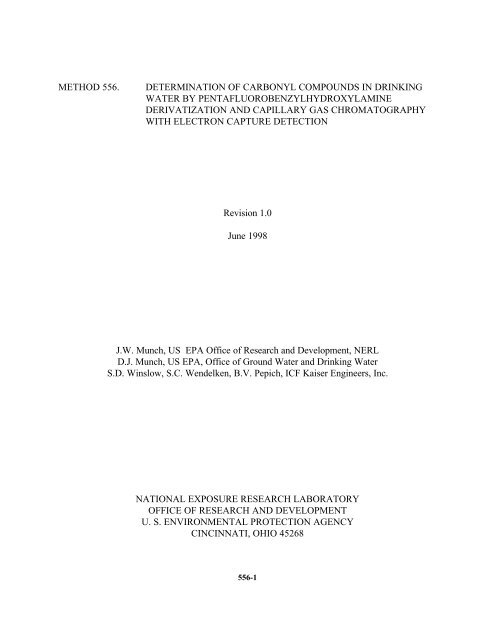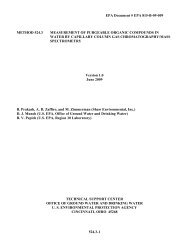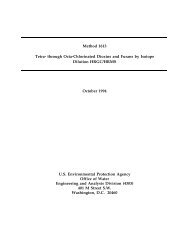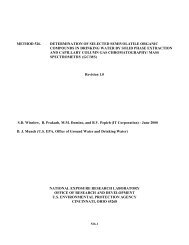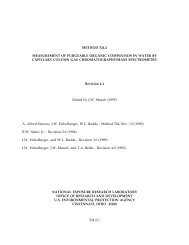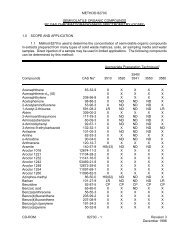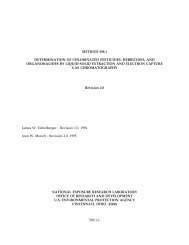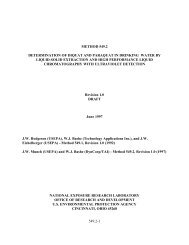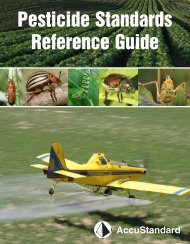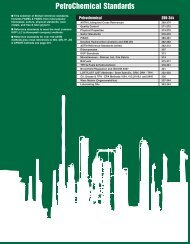EPA Method 556 - US Environmental Protection Agency
EPA Method 556 - US Environmental Protection Agency
EPA Method 556 - US Environmental Protection Agency
Create successful ePaper yourself
Turn your PDF publications into a flip-book with our unique Google optimized e-Paper software.
METHOD <strong>556</strong>.DETERMINATION OF CARBONYL COMPOUNDS IN DRINKINGWATER BY PENTAFLUOROBENZYLHYDROXYLAMINEDERIVATIZATION AND CAPILLARY GAS CHROMATOGRAPHYWITH ELECTRON CAPTURE DETECTIONRevision 1.0June 1998J.W. Munch, <strong>US</strong> <strong>EPA</strong> Office of Research and Development, NERLD.J. Munch, <strong>US</strong> <strong>EPA</strong>, Office of Ground Water and Drinking WaterS.D. Winslow, S.C. Wendelken, B.V. Pepich, ICF Kaiser Engineers, Inc.NATIONAL EXPOSURE RESEARCH LABORATORYOFFICE OF RESEARCH AND DEVELOPMENTU. S. ENVIRONMENTAL PROTECTION AGENCYCINCINNATI, OHIO 45268<strong>556</strong>-1
METHOD <strong>556</strong>DETERMINATION OF CARBONYL COMPOUNDS IN DRINKING WATER BYPENTAFLUORBENZYLHYROXYLAMINE DERIVATIZATION AND CAPILLARYGAS CHROMATOGRAPHY AND ELECTRON CAPTURE DETECTION1. SCOPE AND APPLICATION1.1 This is a gas chromatographic method optimized for the determination of selectedcarbonyl compounds in finished drinking water and raw source water. The analytesapplicable to this method are derivatized to their corresponding pentafluorobenzyloximes. The oxime derivatives are then extracted from the water with hexane. Thehexane extracts are analyzed by capillary gas chromatography with electron capturedetection (GC-ECD) and quantitated using procedural standard calibration. Accuracy,precision, and method detection limit (MDL) data have been generated for thefollowing compounds:Chemical Abstract ServicesAnalyte Registry NumberFormaldehyde 50-00-0Acetaldehyde 75-07-0Propanal 123-38-6Butanal 123-72-8Pentanal 110-62-3Hexanal 66-25-1Heptanal 111-71-7Octanal 124-13-0Nonanal 124-19-6Decanal 112-31-2Cyclohexanone 108-94-1Crotonaldehyde 123-73-9Benzaldehyde 100-52-7Glyoxal (ethanedial) 107-22-2Methyl glyoxal (2-oxopropanal or pyruvic aldehyde) 78-98-81.2 This method applies to the determination of target analytes over the concentrationranges typically found in drinking water. Analyte retention times are in Section 17,Table 1. Other method performance data are presented in Section17, Tables 2-6.Experimentally determined method detection limits (MDLs) for the above listedanalytes are provided in Section 17, Table 3. The MDL is defined as the statistically<strong>556</strong>-2
calculated minimum amount that can be measured with 99% confidence that thereported value is greater than zero. (1) However, it should be noted that backgroundlevels of some method analytes (usually formaldehyde and acetaldehyde) are problematic.The minimum reporting level (MRL) for method analytes, for each analyst/laboratorythat uses this method, will depend on their ability to control backgroundlevels (Sect. 4).1.3 This method is restricted to use by or under the supervision of analysts skilled inliquid-liquid extractions, derivatization procedures and the use of GC and interpretationof gas chromatograms. Each analyst must demonstrate the ability to generateacceptable results with this method, using the procedures described in Section 9.2.0 SUMMARY OF METHOD2.1 A 20 mL volume of water sample is adjusted to pH 4 with potassium hydrogenphthalate (KHP) and the analytes are derivatized at 35 o C for 2 hr with 15 mg of O-(2,3,4,5,6-Pentafluorobenzyl)-hydroxylamine (PFBHA) reagent. The oxime derivativesare extracted from the water with 4 mL hexane. The extract is processedthrough an acidic wash step, and then analyzed by GC-ECD. The target analytes areidentified and quantitated by comparison to a procedural standard (Sect. 3.9). Twochromatographic peaks will be observed for many of the target analytes. Both (E)and (Z) isomers are formed for carbonyl compounds that are asymmetrical, and thatare not sterically hindered. However, the (E) and (Z) isomers may not bechromatographically resolved in a few cases. Compounds where two carbonyl groupsare derivatized, such as glyoxal and methyl glyoxal, have even more possible isomers.See Section17, Table 1 and Figure 1 for the chromatographic peaks used for analyteidentification.NOTE: The absolute identity of the (E) and (Z) isomers was not determined duringmethod development. Other researchers (2,3,4) have reported the first elutingpeak as (E), and the second peak as (Z). For convenience, this method willfollow this convention. Because more than 2 isomers are formed forglyoxal and methyl glyoxal, the peaks used for identification are referred toas “peak 1" and “peak 2."2.2 All results should be confirmed on a second, dissimilar capillary GC column.3. DEFINITIONS3.1 LABORATORY REAGENT BLANK (LRB) -- An aliquot of reagent water or otherblank matrix that is treated exactly as a sample including exposure to all glassware,equipment, solvents and reagents, sample preservatives, internal standards, andsurrogates that are used with other samples. The LRB is used to determine if method<strong>556</strong>-3
analytes or other interferences are present in the laboratory environment, the reagents,or the apparatus.3.2 FIELD REAGENT BLANK (FRB) -- An aliquot of reagent water or other blankmatrix that is placed in a sample container in the laboratory and treated as a sample inall respects, including shipment to the sampling site, storage, preservation, and allanalytical procedures. The purpose of the FRB is to determine if method analytes orother interferences are introduced during sample shipping or storage. For thisanalysis the FRB should not be opened at the sampling site.3.3 LABORATORY FORTIFIED BLANK (LFB) -- An aliquot of reagent water orother blank matrix to which known quantities of the method analytes are added in thelaboratory. The LFB is analyzed exactly like a sample, and its purpose is to determinewhether the methodology is in control, and whether the laboratory is capable ofmaking accurate and precise measurements.3.4 LABORATORY FORTIFIED SAMPLE MATRIX (LFM) -- An aliquot of an environmentalsample to which known quantities of the method analytes are added in thelaboratory. The LFM is analyzed exactly like a sample, and its purpose is to determinewhether the sample matrix contributes bias to the analytical results. Thebackground concentrations of the analytes in the sample matrix must be determinedin a separate aliquot and the measured values in the LFM corrected for backgroundconcentrations.3.5 STOCK STANDARD SOLUTION (SSS) -- A concentrated solution containing oneor more method analytes prepared in the laboratory using assayed reference materialsor purchased from a reputable commercial source.3.6 PRIMARY DILUTION STANDARD SOLUTION (PDS) -- A solution of severalanalytes prepared in the laboratory from stock standard solutions and diluted asneeded to prepare calibration solutions and other needed analyte solutions.3.7 CALIBRATION STANDARD (CAL) -- A solution prepared from the primarydilution standard solution and stock standard solutions and the internal standards andsurrogate analytes. The CAL solutions are used to calibrate the instrument responsewith respect to analyte concentration.3.8 QUALITY CONTROL SAMPLE (QCS) -- A solution of method analytes of knownconcentrations which is used to fortify an aliquot of LRB or sample matrix. TheQCS is obtained from a source external to the laboratory and different from thesource of calibration standards. It is used to check laboratory performance withexternally prepared test materials.<strong>556</strong>-4
3.9 PROCEDURAL STANDARD CALIBRATION -- A calibration method whereaqueous calibration standards are prepared and processed (e.g. purged, extracted,and/or derivatized) in exactly the same manner as a sample. All steps in the processfrom addition of sampling preservatives through instrumental analyses are included inthe calibration. Using procedural standard calibration compensates for any inefficienciesin the processing procedure.3.10 INTERNAL STANDARD (IS) -- A pure analyte added to a sample, extract, orstandard solution in known amount(s) and used to measure the relative responses ofother method analytes and surrogates that are components of the same sample orsolution. The internal standard must be an analyte that is not a sample component.3.11 SURROGATE ANALYTE (SUR) -- A pure analyte, which is extremely unlikely tobe found in any sample, and which is added to a sample aliquot in known amount(s)before extraction or other processing and is measured with the same procedures usedto measure other sample components. The purpose of the SA is to monitor methodperformance with each sample.3.12 METHOD DETECTION LIMIT (MDL) -- The minimum concentration of ananalyte that can be identified, measured and reported with 99% confidence that theanalyte concentration is greater than zero.3.13 MATERIAL SAFETY DATA (MSDS) -- Written information provided by vendorsconcerning a chemical’s toxicity, health hazards, physical properties, fire, andreactivity data including storage, spill, and handling precautions.3.14 CONTINUING CALIBRATION CHECK (CCC) -- A calibration standard containingone or more method analytes, which is analyzed periodically to verify theaccuracy of the existing calibration for those analytes.3.15 MINIMUM REPORTING LEVEL (MRL) -- The minimum concentration of ananalyte that should be reported. This concentration is determined by the backgroundlevel of the analyte in the LRBs and the sensitivity of the method to the analyte.Ideally, the MRL will be at or near the concentration of the lowest calibrationstandard.4. INTERFERENCES4.1 <strong>Method</strong> interferences may be caused by contaminants in laboratory air, solvents,reagents (including reagent water), glassware, sample bottles and caps, and othersample processing hardware that lead to discrete artifacts and/or elevated baselines inthe chromatograms. All of these materials must be routinely demonstrated to be freefrom interferences (less than 1/2 the MRL) under the conditions of the analysis byanalyzing laboratory reagent blanks as described in Section 9.3. Subtracting blankvalues from sample results is not permitted.<strong>556</strong>-5
4.1.1 Before attempting analyses by this method, the analyst must obtain asource of reagent water free from carbonyl compounds and otherinterferences. The most likely interferences are the presence offormaldehyde and acetaldehyde in the reagent water. The most successfultechniques for generating aldehyde free water are (1) exposure to UV light,or (2) distillation from permanganate.4.1.2 Commercially available systems for generating reagent grade water haveproved adequate, if a step involving exposure to UV light is included. Forthe data presented in this method, a Millipore Elix 3 reverse osmosissystem followed by a Milli-Q TOC Plus polishing unit provided reagentwater with background levels of l ug/L or less for each method analyte.Other researchers have reported typical blank values of 1-3 ug/L. (3,4)4.1.3 Distillation of reagent water from acidified potassium permanganate hasbeen reported as an effective method of eliminating background levels ofaldehydes. (2) Distill 500 mL of reagent water to which 64 mg potassiumpermanganate and 1 mL conc. sulfuric acid have been added. In ourlaboratory, this procedure reduced formaldehyde levels to approximately 3ug/L.4.1.4 It may be necessary to purchase reagent grade water. If acceptably cleanreagent grade water is purchased, care must also be taken to protect itfrom contamination caused by contact with laboratory air.4.2 Formaldehyde is typically present in laboratory air and smaller amounts of otheraldehydes may also be found. Care should be taken to minimize exposure of reagentsand sample water with laboratory air. Because latex is a potential aldehydecontaminant source, protective gloves should not contain latex. Nitrile gloves, suchas N-Dex Plus, are acceptable. Bottle caps should be made of polypropylene.Commonly used phenolic resin caps must be avoided because they can introduceformaldehyde contamination into samples.4.3 Reagents must also be free from contamination. Many brands of solvents maycontain trace amounts of carbonyl compounds.4.4 Glassware must be scrupulously cleaned by detergent washing with hot water, andrinses with tap water and distilled water. Glassware should then be drained, dried,and heated in a laboratory oven at 130 o C for several hours before use. Solvent rinseswith methanol or acetonitrile, followed by air drying, may be substituted for the ovenheating. After cleaning, glassware should be stored in a clean environment to preventany accumulation of dust or other contaminants.<strong>556</strong>-6
4.5 Matrix interferences may be caused by contaminants that are coextracted from thesample. The extent of matrix interferences will vary considerably from source tosource, depending upon the nature and diversity of the matrix being sampled.4.6 An interferant that elutes just prior to the acetaldehyde (E) isomer peakon the primary column is typically observed in chlorinated orchloraminated waters. If this peak interferes with the integration of theacetaldehyde (E) isomer peak, then acetaldehyde should be quantitatedusing only the acetaldehyde (Z) isomer, or from the confirmation columndata.5. SAFETY5.1 The toxicity or carcinogenicity of each reagent used in this method has not beenprecisely defined; however, each chemical compound should be treated as a potentialhealth hazard. From this viewpoint, exposure to these chemicals must be reduced tothe lowest possible level by whatever means available. The laboratory is responsiblefor maintaining a current awareness file of OSHA regulations regarding the safehandling of the chemicals specified in this method. A reference file of material safetydata sheets should also be made available to all personnel involved in the chemicalanalysis. Additional references to laboratory safety are available. (5-8)5.2 Formaldehyde and acetaldehyde have been tentatively classified asknown or suspected human or mammalian carcinogens. Glyoxal andmethyl glyoxal have been shown to be mutagenic in in-vitro tests. (2)6. EQUIPMENT AND SUPPLIES (All specifications are suggested. Brand names and/orcatalog numbers are included for illustration only.)6.1 SAMPLE CONTAINERS -- Grab Sample Bottle (aqueous samples) -- 30 mL amberglass, screw cap bottles and caps equipped with Teflon-faced silicone septa. Screwcaps should be polypropylene. Typical phenolic resin caps should be avoided dueto the possibility of sample contamination from formaldehyde. Prior to use,wash bottles and septa according to Section 4.4.6.2 VIALS -- 8 mL or 12 mL vials for the acid wash step (Sect. 11.1.10), and GCautosampler vials, both types must be glass with Teflon-lined polypropylene caps.6.3 VOLUMETRIC FLASKS -- various sizes used for preparation of standards.6.4 BALANCE -- Analytical, capable of accurately weighing to the nearest 0.0001 g.6.5 WATER BATH or HEATING BLOCK -- Capable of maintaining 35 ± 2 o C<strong>556</strong>-7
6.6 GAS CHROMATOGRAPH -- Capillary Gas Chromatograph equipped with asplit/splitless injector, or other injector suitable for trace analysis, and an electroncapture detector.6.6.1 Primary Column -- 30 m x 0.25mm J&W DB-5ms, 0.25 um film thickness(or equivalent). Note: The J&W DB-5 was not found to be equivalent forthis application. The surrogate analyte is not resolved from octanal withthe DB-5 column.6.6.2 Confirmation Column -- 30 m x 0.25 mm Restek Rtx- 1701, 0.25 um filmthickness (or equivalent)7. REAGENTS AND STANDARDS7.1 Reagent grade or better chemicals should be used in all tests. Unless otherwiseindicated, it is intended that all reagents shall conform to the specifications of theCommittee on Analytical Reagents of the American Chemical Society, where suchspecifications are available. Other grades may be used, provided it is first ascertainedthat the reagent is of sufficiently high purity to permit its use without lessening theaccuracy of the determination.7.2 REAGENT WATER --. Reagent water as free as possible from interferences andcontamination is critical to the success of this method. See Section 4.1.7.3 ACETONITRILE -- High purity, demonstrated to be free of analytes andinterferences.7.4 HEXANE -- High purity, demonstrated to be free of analytes and interferences: B&JBrand, GC 2 grade or equivalent.7.5 POTASSIUM HYDROGEN PHTHALATE (KHP) -- ACS Grade or better.7.6 0-(2,3,5,6-PENTAFLUOROBENZYL)-HYDROXYLAMINE HYDROCHLORIDE(PFBHA) -- 98+%, Aldrich cat# 19,448-4. (Store in a desiccator - Do notrefrigerate).7.7 SULFURIC ACID -- ACS Grade or better.7.8 COPPER SULFATE PENTAHYDRATE -- ACS Grade or better.7.9 AMMONIUM CHLORIDE, NH 4 Cl or AMMONIUM SULFATE, (NH 4 ) 2 SO 4 .7.10 SOLUTIONS<strong>556</strong>-8
7.10.1 PFBHA REAGENT -- Prepare a fresh 15 mg/mL solution in reagent waterdaily. Prepare an amount appropriate to the number of samples to bederivatized. One mL of solution is added per sample. For example, if 14sample vials are being extracted, prepare 15 mL of solution. For a 15 mLvolume of solution, weigh 0.225 grams of PFBHA into a dry 40 mL vial,add 15 mL water and shake to dissolve.7.10.2 0.2 N SULFURIC ACID -- Add 5 mL of concentrated sulfuric acid to 900mL of reagent water.7.11 STOCK STANDARD SOLUTIONS -- When a compound purity is assayed to be96% or greater, the weight can be used without correction to calculate theconcentration of the stock standard.7.11.1 INTERNAL STANDARD (IS) -- 1,2-DIBROMOPROPANE, 98+%purity. An alternate compound may be used as the IS at the discretion ofthe analyst. If an alternate is selected, an appropriate concentration willneed to be determined.7.11.1.1 INTERNAL STANDARD STOCK SOLUTION, (10,000ug/mL) -- Accurately weigh approximately 0.1 gram to thenearest 0.0001g, into a tared 10 mL volumetric flaskcontaining hexane up to the neck. After determining weightdifference, fill to mark with hexane. Stock solutions can beused for up to 6 months when stored at -10 o C.7.11.1.2 INTERNAL STANDARD FORTIFIED EXTRACTIONSOLVENT, 400 ug/L in hexane -- This is the solvent used toextract the derivatized samples. The internal standard isadded to the solvent prior to performing the extraction. Thevolume of this solvent to be prepared should be determined bythe sample workload. The following example illustratespreparation of 1 L of fortified solvent. If fewer samples are tobe analyzed each month, prepare smaller batches of workingsolvent. Add 40 uL of internal standard stock solutiondirectly to 1 L of hexane in a volumetric flask. Cap flask andinvert three times to ensure thorough mixing. Transfer to l Lstorage bottle with Teflon lined cap. This solution can beused up to 4 weeks. As a check, run a sample of this workingsolvent on the GC before the first extraction of aqueoussamples. Have enough working solvent available to extractall calibration and aqueous samples in each extraction set.Never use two different batches of working solvent for oneset of extractions.<strong>556</strong>-9
7.11.2 SURROGATE (SUR) -- 2',4',5' -TRIFLUOROACETOPHENONEThis compound was found to be an appropriate surrogate analyte for theseanalyses. However, the chromatograms for this analysis are very crowded,and all possible matrix interferences cannot be anticipated. An alternatecarbonyl compound may be selected as the surrogate analyte if matrixinterferences or chromatographic problems are encountered. Anysurrogate analyte selected must form an oxime derivative, because itspurpose is to monitor the derivatization process. If an alternate surrogateis selected, its concentration may also be adjusted to meet the needs of thelaboratory.7.11.2.1 SURROGATE STOCK SOLUTION, 10,000 ug/mL --Accurately weigh approximately 0.1 gram SUR to the nearest0.0001g, into a 10 mL tared volumetric flask containingacetonitrile up to the neck. After determining weightdifference, fill to mark with acetronitrile. Stock solutions canbe used for up to 6 months when stored at -10 o C or less.7.11.2.2 SURROGATE ADDITIVE SOLUTION, 20 ug/mL -- Dilutethe surrogate stock solution to 20 ug/mL in acetonitrile.This solution can be used up to 3 months when stored at 4 o Cor less.7.11.3 STOCK STANDARD SOLUTION (SSS)Prepare stock standard solutions for each analyte of interest at aconcentration of 1 to 10 mg/mL in acetonitrile, or purchase SSSs orprimary dilution standards (PDSs) from a reputable supplier. <strong>Method</strong>analytes may be obtained as neat materials or as ampulized solutions fromcommercial suppliers. The stock standard solutions should be stored at-10 o C or less and protected from light. Standards prepared in this mannerwere stable for at least 60 days. Standards may be used for longer periodsof time if adequate records of stability are kept. Laboratories should usestandard QC practices to determine when their standards need to bereplaced.7.11.3.1 For analytes which are solids in their pure form, prepare stockstandard solutions by accurately weighing approximately 0.1gram of pure material to the nearest 0.0001g in a 10 mLvolumetric flask. Dilute to volume with acetonitrile.7.11.3.2 Stock standard solutions for analytes which are liquid in theirpure form at room temperature can be accurately prepared inthe following manner.<strong>556</strong>-10
7.11.3.2.1 Place about 9.8 mL of acetonitrile into a 10-mL volumetric flask. Allow the flask to stand,unstoppered, for about 10 min. to allowsolvent film to evaporate from the inner wallsof the volumetric, and weigh to the nearest0.0001 gram.7.11.3.2.2 Use a 100-uL syringe and immediately add 100uL of standard material to the flask by keepingthe syringe needle just above the surface of theacetonitrile. Be sure the standard material fallsdropwise directly into the acetonitrile withoutcontacting the inner wall of the volumetric.7.11.3.2.3 Reweigh, dilute to volume, stopper, then mixby inverting several times. Calculate theconcentration in milligrams per milliliter fromthe net gain in weight.7.11.4 PRIMARY DILUTION STANDARD (PDS) -- The PDS for this methodshould include all method analytes of interest to the analyst. The PDS isprepared by combining and diluting stock standard solutions withacetonitrile to a concentration of 100 ug/mL. Store at -10 o C or less andprotect from light. Standards prepared in this manner were stable for atleast 60 days. Standards may be used for longer periods of time ifadequate records of stability are kept. Laboratories should use standardQC practices to determine when their standards need to be replaced. Thisprimary dilution standard is used to prepare calibration spiking solutions,which are prepared at 5 concentration levels for each analyte, and are usedto spike reagent water to prepare the aqueous calibration standards.7.11.5 CALIBRATION SPIKING SOLUTIONS -- Five calibration spikingsolutions are prepared, each at a different concentration, and are used tospike reagent water to prepare the calibration standards. The calibrationspiking solutions are prepared from the PDS. Store the calibration spikingsolutions at -10 o C or less and protect from light. Solutions prepared in thismanner were stable for at least 60 days. Solutions may be used for longerperiods of time if adequate records of stability are kept. Laboratoriesshould use standard QC practices to determine when solutions need to bereplaced. An example of how the calibration spiking solutions are preparedis given in the following table. Modifications of this preparation schememay be made to meet the needs of the laboratory.<strong>556</strong>-11
PR<strong>EPA</strong>RATION OF CALIBRATION SPIKING SOLUTIONSCal.LevelPDS Conc.,ug/mLVol. PDSStd., uLFinal Vol.,Cal SpikeSol’n, mLsFinal Conc.,Cal SpikeSol’n, ug/mL1 100 250 5 52 100 500 5 103 100 1000 5 204 100 1500 5 305 100 2000 5 407.11.6 PROCEDURAL CALIBRATION STANDARDS -- A designated amountof each calibration spiking solution is spiked into five separate 20 mLaliquots of reagent water in a 30 mL sample container, to produceaqueous calibration standards. The reagent water used to make thecalibration standards should contain the preservation reagents described inSection 8.1.2 (ammonium chloride or ammonium sulfate at 500 mg/L andcopper sulfate pentahydrate at 500 mg/L). Aqueous calibration standardsare processed and analyzed according to the procedures in Section 11.Resulting data are used to generate a calibration curve. An example of thepreparation of aqueous calibration standards is given below. The lowestconcentration calibration standard should be at or near (within 25% of)the MRL. Modifications of this preparation scheme may be made to meetthe needs of the laboratory. Preparing aqueous calibration standards usingvarying volumes of one calibration spiking solution is an acceptablealternative to the example below.PR<strong>EPA</strong>RATION OF PROCEDURAL (AQUEO<strong>US</strong>) CALIBRATIONSTANDARDSCal.LevelCal. Spike Sol’nConc., ug/mLVol. Cal.SpikeSol’n., uLFinal Vol.,Cal StdmLFinal Conc.,Cal Stdug/L1 5 20 20 52 10 20 20 103 20 20 20 204 30 20 20 305 40 20 20 40<strong>556</strong>-12
8. SAMPLE COLLECTION, PRESERVATION, AND STORAGE8.1 SAMPLE VIAL PR<strong>EPA</strong>RATION8.1.1 Grab samples must be collected in accordance with conventional samplingpractices (6) using amber glass 30 mL containers with PTFE-lined screwcaps,or caps with PTFE-faced silicon septa.8.1.2 Prior to shipment to the field, 15 mg of copper sulfate pentahydrate mustbe added to each bottle. This material acts as a biocide to inhibitbacteriological decay of method analytes. If samples to be collected containfree chlorine, then 15mg of ammonium chloride or ammonium sulfate mustalso be added to the bottle prior to sample collection. The ammoniumcompound will react with the free chlorine to form monochloramine, andretard the formation of additional carbonyl compounds. Add thesematerials as dry solids to the sample bottle. The stability of these materialsin concentrated aqueous solution has not been verified.8.2 SAMPLE COLLECTIONNOTE: Aldehydes have been demonstrated to be extremely susceptible tomicrobiological decay. The use of other chlorine reducing agentssuch as sodium thiosulfate or ascorbic acid, has also been shownto produce invalid data. Proper sample collection and preservationis important to obtaining valid data. The data in Section17,Table 6 illustrates the importance of proper sample preservation.8.2.1 Fill sample bottles to just overflowing but take care not to flush out thesample preservation reagents. The capped sample should be head-spacefree.8.2.2 When sampling from a water tap, remove the aerator so that no air bubbleswill be trapped in the sample. Open the tap, and allow the system to flushuntil the water temperature has stabilized (usually about 3-5 min). Collectsamples from the flowing system.8.2.3 When sampling from an open body of water, fill a 1 quart wide-mouthbottle or 1L beaker with sample from a representative area, and carefullyfill sample bottles from the container.8.2.4 After collecting the sample, cap carefully to avoid spillage, and agitate byhand for 1 min.<strong>556</strong>-13
8.3 SAMPLE STORAGE/HOLDING TIMES8.3.1 Samples must be iced or refrigerated at 4 o C and maintained at theseconditions away from light until extraction. Samples must be extractedwithin 7 days of sampling. However, since aldehydes are subject to decayin stored samples, all samples should be derivatized and extracted as soonas possible.NOTE: A white or blue precipitate is likely to occur. This is normal anddoes not indicate any problem with sample collection or storage.8.3.2 Extracts (Sect. 11.1.11) must be stored at 4 o C or less away from light inglass vials with Teflon-lined caps. Extracts must be analyzed within 14days of extraction.8.4 FIELD REAGENT BLANKS -- Processing of a field reagent blank (FRB) isrequired along with each sample set. A sample set is composed of the samplescollected from the same general sampling site at approximately the same time. Fieldreagent blanks are prepared at the laboratory before sample vials are sent to the field.At the laboratory, fill a sample container with reagent water (Sect. 7.2), add samplepreservatives as described in Section 8.1.2, seal and ship to the sampling site alongwith the empty sample containers. FRBs should be confirmed to be free (less than1/2 the MRL) of all method analytes prior to shipping them to the field. Return theFRB to the laboratory with filled sample bottles. DO NOT OPEN THE FRB ATTHE SAMPLING SITE. If any of the analytes are detected at concentrations equalto or greater than 1/2 the MRL , then all data for the problem analyte(s) should beconsidered invalid for all samples in the shipping batch.9. QUALITY CONTROL9.1 Each laboratory that uses this method is required to operate a formal quality control(QC) program. Minimum QC requirements are initial demonstration of laboratorycapability (which includes calculation of the MDL), analysis of laboratory reagentblanks, laboratory fortified blanks, field reagent blanks, laboratory fortified samplematrices, and QC samples. Additional QC practices are encouraged.9.2 INITIAL DEMONSTRATION OF CAPABILITY (IDC) -- Requirements for theinitial demonstration of laboratory capability are described in the following sectionsand summarized in Section 17, Table 7.9.2.1 Initial demonstration of low system background. (See Sect. 9. 3)9.2.2 Initial demonstration of precision. Prepare, derivatize, extract, and analyze4-7 replicate LFBs fortified at 20 ug/L, or other mid-range concentration,over a period of at least 2 days. Generating the data over a longer period<strong>556</strong>-14
of time, e.g. 4 or 5 days may produce a more realistic indication of day today laboratory performance. The relative standard deviation (RSD) of theresults of the replicate analyses must be less than 20%.9.2.3 Initial demonstration of accuracy. Using the same set of replicate datagenerated for Section 9.2.2, calculate average recovery. The averagerecovery of the replicate values must be within ± 20% of the true value.9.2.4 MDL (1) determination. Replicate analyses for this procedure should bedone over at least 3 days (both the sample derivatization/extraction and theGC analyses should be done over at least 3 days). Prepare at least 7replicate LFBs at a concentration estimated to be near the MDL. Thisconcentration may be estimated by selecting a concentration at 2-5X thenoise level. Analyze the seven replicates through all steps of Section 11.Calculate the MDLwhere:MDL = St ( n - 1, 1 - alpha = 0.99)t (n-1,1-alpha = 0.99) = Student's t value for the 99% confidence level withn-1 degrees of freedomn = number of replicatesS = standard deviation of replicate analyses.NOTE: Do not subtract blank values when performing MDL calculations.9.2.5 Minimum Reporting Level (MRL) -- Although an MDL can be calculatedfor analytes that commonly occur as background contaminants, thecalculated MDLs should not be used as the MRL for each analyte.<strong>Method</strong> analytes that are seen in the background (typically formaldehyde,acetaldehyde) should be reported as present in field samples, only aftercareful evaluation of the background levels. It is recommended that aMRL be established at the mean LRB concentration + 3F, or three timesthe mean LRB concentration, whichever is greater. This value should becalculated over a period of time, to reflect variability in the blankmeasurements. It is recommended that this value be used as a minimumreporting level in order to avoid reporting false positive results.9.3 LABORATORY REAGENTS BLANKS (LRB) -- Each time a set of samples isextracted or reagents are changed, a LRB must be analyzed. If within the retentiontime window of any analyte, the LRB produces a peak that would prevent thedetermination of that analyte, determine the source of contamination and eliminatethe interference before processing samples. Because background contamination is a<strong>556</strong>-15
significant problem for several method analytes, it is highly recommended that theanalyst maintain a historical record of LRB data. If target analytes are detected in theLRB at concentrations equal to or greater than 1/2 the MRL (Sect. 9.2.5), then alldata for the problem analyte(s) should be considered invalid for all samples in theextraction batch.9.4 CONTINUING CALIBRATION CHECK/LABORATORY FORTIFIED BLANK --Since this methodology is based on procedural standard calibration, a LFB and thecalibration check sample (CCC) are prepared and analyzed in the same manner.Laboratory fortified blank QC requirements are therefore omitted. Calibrationprocedure options and the QC acceptance criteria associated with them are fullydescribed in Sect 10.3. Please refer to that section for these criteria.9.5 INTERNAL STANDARD--The analyst must monitor the IS response peak area ofall injections during each analysis day. A mean IS response is determined from thefive point calibration curve. The IS response for any chromatographic run should notdeviate from this mean IS response by more than 30%. If a deviation greater than30% occurs with an individual extract inject a second aliquot of that extract.9.5.1 If the reinjected aliquot produces an acceptable internal standard response,report results for that aliquot.9.5.2 If a deviation of greater than 30% is obtained for the reinjected extract, theanalyst should check the calibration by analyzing the most recentlyacceptable calibration standard. If the calibration standard fails the criteriaof Section 9.5, recalibration is in order per Section 10. If the calibrationstandard is acceptable, extraction of the sample should be repeatedprovided the sample is still within the holding time. Otherwise, reportresults obtained from the reinjected extract, but annotate as suspect.9.6 SURROGATE RECOVERY--The surrogate standard is fortified into the aqueousportion of all calibration standards, samples, FRBs and LRBs. The surrogate is ameans of assessing method performance from derivatization to final chromatographicmeasurement.9.6.1 When surrogate recovery from a sample, blank, or CCC is 130%, check (1) calculations to locate possible errors, (2) standardsolutions for degradation, (3) contamination, and (4) instrumentperformance. If those steps do not reveal the cause of the problem,reanalyze the extract.9.6.2 If the extract reanalysis meets the surrogate recovery criterion, report onlydata for the reanalyzed extract.<strong>556</strong>-16
9.6.3 If the extract reanalysis fails the 70-130% recovery criterion, the analystshould check the calibration by analyzing the most recently acceptablecalibration standard. If the calibration standard fails the criteria of Section9.6.1, recalibration is in order per Section 10. If the calibration standard isacceptable, it may be necessary to extract another aliquot of sample ifsample holding time has not been exceeded. If the sample reextract alsofails the recovery criterion, report all data for that sample as suspect.9.7 LABORATORY FORTIFIED SAMPLE MATRIX (LFM)9.7.1 Within each analysis set, a minimum of one field sample is fortified as aLFM for every 20 samples analyzed. The LFM is prepared by spiking asample with an appropriate amount of the calibration standard. Theconcentrations 5, 10, and 20 ug/L are suggested spiking concentrations.Select the spiking concentration that is closest to, and at least twice thematrix background concentration. Use historical data or rotate through thedesignated concentrations to select a fortifying concentration. Selecting aduplicate vial of a sample that has already been analyzed, aids in theselection of appropriate spiking levels.9.7.2 Calculate the percent recovery (R) for each analyte, after correcting themeasured concentration, A, from the fortified sample for the backgroundconcentration, B, measured in the unfortified sample, i.e.,R ' (A&B)C (100where C is the fortified concentration. Compare these values tocontrol limits appropriate for reagent water data collected in thesame fashion.9.7.3 Recoveries may exhibit a matrix dependence. For samples fortified at orabove their native concentration, recoveries should range between 70 -130%. If the accuracy of any analyte falls outside the designated range,and the laboratory performance for that analyte is shown to be in control,the accuracy problem encountered with the fortified sample is judged to bematrix related, not system related. The result for that analyte in theunfortified sample is labeled suspect/matrix to inform the data user that theresults are suspect due to matrix effects. Repeated failure to meet thesuggested recovery criteria indicates potential problems with the extractionprocedure and should be investigated.<strong>556</strong>-17
9.8 FIELD DUPLICATES -- Within each analysis batch, a minimum of one field sampleshould be analyzed in duplicate. Duplicate sample analyses serve as a check onsampling and laboratory precision.9.8.1 Calculate the relative percent difference (RPD) for duplicate measurements(FD1 and FD2) as shown below.RPD 'FD1&FD2(FD1%FD2)/2 ((100)9.8.2 Relative percent differences for laboratory duplicates should fall in therange of ± 30 %. Greater variability may be observed for target analyteswith concentrations near their MRL.9.9 QUALITY CONTROL SAMPLE (QCS) -- At least quarterly, analyze a QCS froman external source. If measured analyte concentrations are not of acceptableaccuracy (60-140% of the expected value), check the entire analytical procedure tolocate and correct the problem source.9.10 ASSESSING(Z/E) RATIOS -- In addition to monitoring analyte response fromCCC/LFB, the ratio of the peak areas of each isomer pair should be monitored.When samples and standards are processed and analyzed by exactly the sameprocedure, the ratio of the (Z/E) isomers produced by each method analyte will bereproducible. This information can be used as a QC check to avoid biased resultscaused by an interferant with one isomer of the pair. Calculate and record the ratio ofthe peak area of the first eluting isomer (designated (E)) to the second eluting isomer(designated (Z)). This ratio will be used in data evaluation Section 12.4.10. CALIBRATION AND STANDARDIZATION10.1 Demonstration and documentation of acceptable initial calibration is required beforeany samples are analyzed, and is required intermittently throughout sample analysis.After initial calibration is successful, the analyst may choose one of two options formaintaining on-going calibration. The first option is to verify the initial calibrationdaily using a minimum of 2 calibration standards. The other option is dailycalibration of the method with all 5 calibration standards. These options are furtherdescribed in Section 10.3.10.2 INITIAL CALIBRATION CURVE10.2.1 Establish GC operating parameters equivalent to the suggestedspecifications in Section 17, Table 1. The GC system must be calibratedusing the internal standard (IS) technique. Other GC columns or GCconditions may be used if equivalent or better performance can bedemonstrated.<strong>556</strong>-18
10.2.2 Five calibration standards are recommended to calibrate over the range ofapproximately 2-40 ug/L. The lowest level standard will depend upon thelevel of blank contamination for each analyte (Sect. 7.11.6).10.2.3 Prepare each calibration standard by the procedural standard calibrationmethod. <strong>Method</strong> analytes are fortified into reagent water and carriedthrough the entire extraction and derivatization procedure described inSection 11.10.2.4 Inject 1 uL of each calibration standard extract into the GC and tabulatepeak area response and concentration for each analyte and the internalstandard. NOTE: The formaldehyde peak will be much larger (for thesame concentration) than the other analyte peaks. The formaldehyde peakmay need to be attenuated on some instruments/data systems to avoidsignal saturation.10.2.5 (Z/E) ISOMERS -- Two isomers, referred to as (E) and (Z), are formed formost asymmetrical carbonyl compounds derivatized with PFBHA.Chromatographic resolution is usually obtained with the columns suggestedin Section 6.6 for acetaldehyde, propanal, butanal, pentanal, hexanal,heptanal, octanal, and crotonaldehyde (see chromatograms in Fig. 1 andFig 2). With dicarbonyl species such as glyoxal and methyl glyoxal, (E)and (Z) isomerism occurs from oxime formation with both carbonyl groups,increasing the number of isomers. The demonstration data included in thismethod has used two distinct isomer peaks each for glyoxal and methylglyoxal. Use one of the following methods for both calibration andquantitation of each method analyte.(a)(b)Use the sum of the isomer peak areas for each constituent for bothcalibration and quantitation.Use the peak area of each individual isomer to independentlycalculate a concentration for each isomer. Then average the amountof the two isomers to report one value for the analyte.10.2.6 Generate a calibration curve for each analyte by plotting the area ratios(A a /A is ) against the concentration ratios (C a /C is ) of the five calibrationstandards where:A a is the peak area of the analyte (or analyte isomer pair),A is is the peak area of the internal standard,C a is the concentration of the analyte, andC is is the concentration of the internal standard.<strong>556</strong>-19
10.2.7 This curve must always be forced through zero and can be defined as eitherfirst or second order. Forcing zero allows for a better estimate of thebackground level of method analytes.10.2.8 A data system is recommended to collect the chromatographic data, tocalculate relative response factors, and calculate either linear or secondorder calibration curves.10.2.9 VERIFICATION OF CALIBRATION STANDARD MATERIALS --Analyze a LFB prepared from standard materials from a source other thanthose used to prepare the initial calibration curve (Sect. 3.8, QCS).Calculate the concentration of this QCS from the calibration curve. Thecalculated concentration of the QCS must agree within 60-140% of its truevalue. This step verifies the validity of calibration standard materials andthe calibration curve prior to sample analyses.10.3 OPTIONS FOR ON-GOING CALIBRATIONThe time, temperature, pH, and PFBHA concentration will all affect the rate,efficiency and reproducibility of the derivatization reaction. It is critical that thoseparameters be controlled. Calibration frequency will depend upon the laboratory’sability to control these parameters so that continuing calibration check standardcriteria can be met. Some laboratories may find it more productive to prepare andanalyze a calibration curve with each batch of samples. A batch of samples for thismethodology should not exceed 20 samples, including field samples, FRBs,laboratory duplicates, and fortified sample matrices.10.3.1 CONTINUING CALIBRATION CHECK (CCC) OPTION--The analystmust periodically verify calibration during the analysis of samples in orderto ensure accuracy of analytical results. Prepare a minimum of one lowlevel(suggested concentration 2-5 ug/L) and one mid-level (suggestedconcentration 10-30 ug/L) calibration standard with each batch of samples.Verify calibration using these two standards, prior to analyzing any of thesample extracts from the batch. In addition, reanalyze one of these twostandard extracts after every tenth sample extract, and after the last samplein an analysis batch to ensure instrument stability throughout the analysisbatch. Recovery must be within 70-130% of the true value for the midlevelstandard, and within 50-150% of the true value for the low-levelstandard.10.3.2 DAILY CALIBRATION OPTION -- The analyst may choose to create anew calibration curve for each batch of samples by preparing and analyzinga standard at all five calibration concentrations, with each batch of samples.If this option is selected, the calibration standard extracts should beanalyzed prior to the analysis of sample extracts. To ensure that sensitivity<strong>556</strong>-20
and performance of the method has not changed significantly betweensample batches , or changed since the IDC, the following performancecheck is required. The response (peak area) of the internal standard,surrogate and each method analyte in the mid-level standard (suggestedconcentration 10-30 ug/L), must be within 50-150% of the mean peak areafor that analyte in the initial demonstration of precision replicates (Sect.9.2.2). One of the calibration standard extracts must be reanalyzed afterevery tenth sample extract, and after the last sample in an analysis batch toensure instrument stability throughout the analysis batch. Recovery mustbe within 70 to 130% of the true value for mid- and high-level calibrationstandards, and within 50-150% of the true value for the low-level standard(suggested concentration 2-5 ug/L).11. PROCEDURE11.1 SAMPLE EXTRACTION -- Once samples have been opened, process the samplesstraight through to step 11.1.11. There is no known “safe” stopping point oncesample processing has begun. Samples are derivatized and extracted in the samplebottle in which they were collected. Transferring the sample to another container forderivatization and extraction has been shown to cause a loss of method analytes.11.1.1 Remove the samples from storage and allow them to equilibrate to roomtemperature.11.1.2 Remove 10 mL of sample and discard. Mark the level of the remainingsample volume on the outside of the bottle, for later sample volumedetermination.11.1.3 Add 200 mg KHP to the sample for pH adjustment.11.1.4 Add 20 uL surrogate solution (Sect 7.11.2.2).11.1.5 Add 1 mL of freshly prepared PFBHA Reagent as per Section 7.10.1. Capand swirl gently to mix.11.1.6 Place all samples in a constant-temperature water bath set at 35 ± 2 o C for2 hrs. Remove vials and cool to room temperature for 10 min.11.1.7 To each vial add 0.05 mL (approximate 2 to 4 drops) of concentratedsulfuric acid. This prevents the extraction of excess reagent, which willcause chromatographic interferences.11.1.8 Add 4 mL of hexane that contains the internal standard (as per Sect.7.11.1.2).<strong>556</strong>-21
11.1.9 Shake manually for 3 min. Let stand for approximately 5 min to permitphases to separate.11.1.10 Draw off hexane layer (top layer) using a clean disposable Pasteur pipetfor each sample into a smaller 8 mL vial containing 3 mL 0.2 N sulfuricacid. Shake for 30 sec and let stand for 5 min for phase separation.NOTE: This acid wash step further reduces the reagent and otherinterferants from the final extract. Do not skip this step.11.1.11 Draw off top hexane layer using another clean disposable pipet for eachsample and place in two 1.8 mL autosampler vials per sample. Store extraautosampler vials as a backup extract. Extracts may be stored for up to 14days at 4 o C.11.1.12 Sample Volume Determination -- Discard remaining water sample andhexane in each sample bottle. Fill with water to the level indicated by themark made in Section 11.1.2. Pour the water into a 25 mL graduatedcylinder and measure the volume to the nearest mL. Record the samplevolume for each sample.Alternately, if a laboratory has control over the brand and style of thesample bottles being used, the exact volume of a number of bottles fromthe same manufacturer and lot may be measured, and the average bottlevolume minus 10 mL may be used as the sample volume for all samplesusing the same lot of sample bottles. A minimum of 10 % of the samplebottles obtained from the same manufacturer, from the same lot should bemeasured.11.2 GAS CHROMATOGRAPHY11.2.1 Analyze the extracts by GC/ECD. Table 1 (Sect. 17) summarizesrecommended GC operating conditions and retention times observed usingthis method. Figure 1 illustrates the performance of the recommendedprimary column with the method analytes. Figure 2 illustrates theperformance of the recommended confirmation column with the methodanalytes. Other GC columns or chromatographic conditions may be used ifthe requirements of Section 9 are met.11.2.2 The width of the retention time window used to make identificationsshould be based on measurements of actual retention time variations ofstandards over the course of time. Plus or minus three times the standarddeviation of the retention time for a compound can be used to calculate asuggested window size; however the experience of the analyst shouldweigh heavily in the interpretation of chromatograms.<strong>556</strong>-22
11.2.3 If an analyte peak area exceeds the range of the calibration curve, theextract may be diluted with the hexane extraction solvent (that contains theinternal standard) and reanalyzed. Incorporate the dilution factor into finalconcentration calculations. The analyst must not extrapolate beyond thecalibration range established.12. DATA ANALYSIS AND CALCULATIONS12.1 Identify the method analytes in the sample chromatogram by comparing the retentiontime of the suspect peak to the retention time of an analyte peak (or isomer peaks) ina calibration standard or the laboratory fortified blank.12.2 Calculate the analyte concentrations using the first or second order calibrationcurves generated as described in Section 10.12.3 For any analytes that are found, adjust the calculated concentration to reflect the truesample volume determined in Section 11.1.12.12.4 Prior to reporting the data, the chromatogram should be reviewed for any incorrectpeak identification or poor integration. If a confirmation column has been used, allidentifications should be verified using the retention time data from that analysis. Inaddition, the (Z/E) isomer ratio should be within 50% of the ratio observed instandards. If the (Z/E) ratio does not meet these criteria, it is likely that aninterferant occurred at the retention time of one of the isomer peaks. In this case,the amount indicated by the lower of the 2 isomer peaks should be reported. (Thismay require that the analyst recalculate the analyte amount using individual isomerpeaks for quantitation.) If one peak of the isomeric pair is missing, the identificationis not confirmed and should not be reported.12.5 Analyte concentrations are reported in ug/L.13. METHOD PERFORMANCE13.1 Precision and accuracy data are presented in Section 17. Data are presented forthree water matrices: reagent water (Table 2), chlorinated “finished” surface water(Table 4) , and untreated “raw” surface water (Table 5). These data, as well as theMDL data in Table 3, were generated in two laboratories. Data in Table 2 andcolumn A of Table 3, were generated in one laboratory, while data in column B ofTable 3 and in Tables 4 and 5 were generated in a second laboratory. <strong>Method</strong>performance in both laboratories was similar.13.2 DERIVATIZATION PARAMETERS -- This method is a procedural standardmethod that will generate accurate and precise results when used as written. Thetime, temperature, pH, and PFBHA concentration will all affect the rate, efficiency<strong>556</strong>-23
and reproducibility of the derivatization reaction. It is critical that those parametersbe controlled. Calibration frequency will depend upon the laboratory’s ability tocontrol these parameters. Some laboratories may need to prepare and analyze acalibration curve with each batch of samples. Of all the method analytes, glyoxal,methyl glyoxal, benzaldehyde, crotonaldehyde and cyclohexanone are the mostdifficult to derivatize. Poor sensitivity for any of these compounds indicates thatthere may be a problem with the reaction conditions. Measurements of nonanal,decanal, glyoxal and methyl glyoxal appear to be less precise than the measurementof other analytes.13.3 The importance of low background levels of formaldehyde and acetaldehyde cannotbe overemphasized. Some laboratories or reagent waters may also containbackground amounts of other method analytes. Care must be taken to avoidreporting false positive results that result from background contamination.13.4 The importance of proper sample collection and preservation also cannot beoveremphasized. Holding time studies in various matrices showed better than 70%recovery of all method analytes when samples were collected, preserved, and storedaccording to Section 8, and analyzed within 7 days. There were variations in therecovery of analytes from fortified samples from different matrices. Therefore, it isstrongly recommended that samples be analyzed as soon as possible after collection.The data in Section 17, Table 6 illustrates the dramatic difference between apreserved and a non-preserved sample.13.5 Data for crotonaldehyde is not listed in Section 17, Tables 4-6, because it was notincluded in the standard mixtures being used at the time that those data werecollected. However, crotonaldehyde was included in many other studies notpresented here, and its performance was similar to other method analytes.14. POLLUTION PREVENTION14.1 This method uses a micro-extraction procedure which requires very small quantitiesof organic solvents.14.2 For information about pollution prevention that may be applicable to laboratoryoperations, consult “Less is Better: Laboratory Chemical Management for WasteReduction” available from the American Chemical Society’s Department ofGovernment Relations and Science Policy, 1155 16th Street N.W., Washington,D.C. 20036.15. WASTE MANAGEMENT15.1 Due to the nature of this method tHere is little need for waste management. Onlysmall volumes of solvents are used. The matrices of concern are finished drinkingwater or source water. However, the <strong>Agency</strong> requires that laboratory waste<strong>556</strong>-24
16. REFERENCESmanagement practices be conducted consistent with all applicable rules andregulations, and that laboratories protect the air, water, and land by minimizing andcontrolling all releases from fume hoods and bench operations. Also, compliance isrequired with any sewage discharge permits and regulations, particularly thehazardous waste identification rules and land disposal restrictions. For furtherinformation on waste management, consult “The Waste Management Manual forLaboratory Personnel” also available from the American Chemical Society at theaddress in Section 14.2.1. Glaser, J.A., D.L. Foerst, G.D. McKee, S.A. Quave, and W.L. Budde, "TraceAnalyses for Wastewaters," Environ. Sci. Technol. 1981, 15, 1426-1435.2. Standard <strong>Method</strong> Number 6252B, “PFBHA Liquid-Liquid Extraction GasChromatographic <strong>Method</strong>”, Standard <strong>Method</strong>s for the Examination of Water andWastewater, pp. 6-77 to 6-83, American Public Health Assoc., Washington, D.C.,1995.3. Sclimenti, M.J., S.W. Krasner, W.H. Glaze, and H.S. Weinberg,“Ozone DisinfectionBy-Products: Optimization of the PFBHA Derivatization <strong>Method</strong> for the Analysis ofAldehydes”, In Advances in Water Analysis and Treatment, Proc. AWWA WaterQuality Technology Conf., 1990,pp 477-501.4. Glaze, W.H. and H.S. Weinberg, Identification and Occurrence of Ozonation By-Products in Drinking Water, American Water Works Assoc. Research Foundation,Denver, CO., 1993, pp19-22.5. "OSHA Safety and Health Standards, General Industry," (29CRF1910).Occupational Safety and Health Administration, OSHA 2206, (Revised, Jan.1976).6. ASTM Annual Book of Standards, Part II, Volume 11.01, D3370-82, "StandardPractice for Sampling Water," American Society for Testing and Materials,Philadelphia, PA, 1986.7. “Carcinogens-Working with Carcinogens”, Publication No. 77-206, Department ofHealth, Education, and Welfare, Public Health Service, Center for Disease Control,National Institute of Occupational Safety and Health, Atlanta, Georgia, August1977.8. “Safety In Academic Chemistry Laboratories”, 3rd Edition, American ChemicalSociety Publication, Committee on Chemical Safety, Washington, D.C., 1979.<strong>556</strong>-25
17. TABLES, DIAGRAMS, FLOWCHARTS, AND VALIDATION DATATABLE 1. CHROMATOGRAPHIC CONDITIONS AND RETENTION DATA FORANALYTE DERIVATIVESColumn AColumn BANALYTE RT (min) Peak #, Fig 1 RT (min) Peak #, Fig.2Formaldehyde 10.69 2 13.35 2Acetaldehyde (E) 14.23 3 16.71 3Acetaldehyde (Z) 14.49 4 17.00 4Propanal (E) 17.36 5 19.59 5Propanal (Z) 17.62 6 19.86 6Butanal (E) 20.58 7 22.62 7Butanal (Z) 20.81 8 22.88 8Crotonaldehyde (E) 22.67 9 24.79 not shownCrotonaldehyde (Z) 23.00 10 25.31 not shownPentanal (E) 23.82 11 25.54 9Pentanal (Z) 24.01 12 25.70 10Hexanal (E) 26.99 13 28.74 11Hexanal (Z) 27.16 14 28.93 12Cyclohexanone 29.42 15 31.40 13Heptanal (E) 30.05 16 31.64 14Heptanal (Z) 30.16 17 31.78 15Octanal (E) 33.01 19 34.45 16Octanal (Z) 33.09 20 34.57 18Benzaldehyde 33.88 21 36.74 19Nonanal (E) 35.89 22 37.18 20Decanal 38.63 23 39.80 21<strong>556</strong>-26
Column AColumn BANALYTE RT (min) Peak #, Fig 1 RT (min) Peak #, Fig.2Glyoxal (peak1) 40.87 24 43.74 22Glyoxal (peak 2) 41.09 25 43.86 23Methyl glyoxal(peak 1)Methyl glyoxal(peak 2)1.2 dibromopropane(Internal standard)2',4',5' trifluoroacetophenone(Surrogate)41.22 26 43.86 2441.88 27 44.38 256.14 1 7.84 132.84 18 34.45 17Column A-Column B-DB-5ms, 30 m x 0.25mm i.d., 0.25 um film thickness, injector temp. 220 o C, headpressure 15 psi, detector temp. 300 o C, splitless injection, 1 min split delay.Temperature program: 50 o C for 1 min, program at 4 o C/min to 220 o C, program at20 o C/min to 250 o C and hold at 250 o C for 10 min. (Figure 1)Rtx-1701, 30 m x 0.25 mm i.d., 0.25 um film thickness, injector temp. 180 o C, headpressure 15 psi, detector temp. 300 o C,splitless injection, 1 min split delay.Temperature program: 50 o C for 1 min, program at 4 o C/min to 220 o C, program at20 o C/min to 250 o C and hold at 250 o C for 10 min. (Figure 2)Carrier gas- HeliumDetector gas- P5 Argon/Methane<strong>556</strong>-27
TABLE 2. PRECISION AND ACCURACY IN REAGENT WATER (n=8) aANALYTEFortifiedConc. (ug/L)Mean Conc.Measured(ug/L)StandardDeviationRelativeStd Dev (%)MeanAccuracy(%)Formaldehyde 20.0 19.5 0.792 4.0 98Acetaldehyde 20.0 19.2 0.784 4.1 96Propanal 20.0 19.5 0.873 4.5 97Butanal 20.0 19.8 1.12 5.6 99Crotonaldehyde 20.0 19.8 1.11 5.6 99Pentanal 20.0 20.0 1.10 5.5 100Hexanal 20.0 19.7 1.25 6.4 98Cyclohexanone 20.0 19.2 0.729 3.8 96Heptanal 20.0 19.2 1.37 7.1 98Octanal 20.0 19.1 1.32 6.9 95Benzaldehyde 20.0 19.1 0.362 1.9 95Nonanal 20.0 18.8 1.09 5.8 94Decanal 20.0 18.7 1.20 6.4 93Glyoxal 20.0 18.4 0.571 3.1 92Methyl glyoxal 20.0 17.9 1.36 7.6 90a- Analyzed over 2 days on the primary chromatographic column (DB-5ms).<strong>556</strong>-28
TABLE 3. METHOD DETECTION LIMITS IN REAGENT WATER (n=8)ANALYTEFortifiedConc. (ug/L)MDL(ug/L)Column AMDL(ug/L)Column BFormaldehyde 2.0 0.36 0.11Acetaldehyde 2.0 0.21 0.14Propanal 2.0 0.41 0.06Butanal 2.0 0.35 0.12Crotonaldehyde 2.0 0.28 0.09Pentanal 2.0 0.47 0.17Hexanal 2.0 0.42 0.35Cyclohexanone 2.0 0.29 0.10Heptanal 2.0 0.43 0.71Octanal 2.0 0.60 0.12Benzaldehyde 2.0 0.31 0.06Nonanal 2.0 0.74 0.40Decanal 2.0 1.0 0.82Glyoxal 2.0 0.59 0.21Methyl glyoxal 2.0 0.81 0.22Column A= DB-5msColumn B= Rtx-1701<strong>556</strong>-29
TABLE 4. PRECISION AND ACCURACY IN CHLORINATED TAP WATER(n=4) aANALYTEFortifiedConc. (ug/L)Mean Conc.Measured(ug/L)StandardDeviationRelativeStd Dev (%)MeanAccuracy(%)Formaldehyde 20.0 21.6 0.197 0.9 108Acetaldehyde* 20.0 19.6 0.263 1.3 98Propanal 20.0 19.5 0.178 0.9 98Butanal 20.0 20.2 0.254 1.3 101Pentanal 20.0 20.3 0.318 1.6 101Hexanal 20.0 20.2 0.382 1.9 101Cyclohexanone 20.0 20.7 0.247 1.2 103Heptanal 20.0 20.5 3.073 2.5 103Octanal 20.0 20.3 0.979 4.8 102Benzaldehyde 20.0 21.2 0.432 2.0 106Nonanal 20.0 20.0 0.828 4.2 100Decanal 20.0 19.8 1.203 6.1 99Glyoxal 20.0 22.3 0.783 3.5 112Methyl glyoxal 20.0 21.0 0.775 3.7 105a- Analyzed on the primary chromatographic column (DB-5ms).*- Values taken from the confirmation column.<strong>556</strong>-30
TABLE 5. PRECISION AND ACCURACY IN UNTREATED SURFACE WATER (n=4) aANALYTEFortifiedConc. (ug/L)Mean Conc.Measured(ug/L)StandardDeviationRelativeStd Dev (%)MeanAccuracy(%)Formaldehyde 20.0 19.4 0.941 4.8 97Acetaldehyde* 20.0 20.0 0.891 4.4 100Propanal 20.0 19.5 0.966 5.0 97Butanal 20.0 18.9 0.965 5.1 94Pentanal 20.0 18.7 1.00 5.4 93Hexanal 20.0 18.2 1.080 6.0 91Cyclohexanone 20.0 17.3 0.943 5.4 87Heptanal 20.0 18.0 0.995 5.5 90Octanal 20.0 18.3 1.017 5.6 92Benzaldehyde 20.0 17.2 1.118 6.5 86Nonanal 20.0 18.4 0.881 4.8 92Decanal 20.0 18.1 0.908 5.0 90Glyoxal 20.0 20.5 1.10 5.4 102Methyl glyoxal 20.0 23.3 0.799 3.4 116a- Analyzed on the primary chromatographic column (DB-5ms).*- Values taken from the confirmation column.<strong>556</strong>-31
TABLE 8. QUALITY CONTROL REQUIREMENTS (SUMMARY)Reference Requirement Specification and Frequency Acceptance CriteriaSect. 10.2InitialCalibrationUse internal standard technique togenerate curve with five standardsthat span the approximate rangeof 2-40 ug/L. First or secondorder curves must be forcedthrough zero. Either sum E/Zisomer areas or average theamount of each isomer.Calculate E/Z ratios for analytes.Run QCS.QCS must agree within60 -140 %.Lowest concentrationshould be near MRL.Sect. 9.3LaboratoryReagent Blank(LRB)Include LRB with each extractionbatch (up to 20 samples).Analyze prior to analyzingsamples and determine to be freeof interferences.All analytes < 1/2 MRLSect. 10.3.1ContinuingCalibrationCheck (CCC)OptionVerify initial calibration byrunning CCCs prior to analyzingsamples, after 10 samples, andafter the last sample.Recovery for mid-levelCCC must be 70-130%of the true value,recovery for low levelmust be 50-150% of thetrue value.Sect. 10.3.2DailyCalibrationOptionCalibrate daily, but verify thatsensitivity and performance havenot changed significantly sinceIDC.Peak areas for IS, SUR,and method analytes formid-level CAL std mustbe +/- 50% of the peakareas obtained for thatCAL std during IDC.Sect. 8.4Field ReagentBlanks (FRB)1 per shipping batch All analytes < 1/2 MRLSect. 9.5InternalStandard (IS)1,2-Dibromopropane is added toall samples, blanks and standardsIS area counts must be70 - 130% of the averageinitial calibration areacounts<strong>556</strong>-34
Reference Requirement Specification and Frequency Acceptance CriteriaSect. 9.6SurrogateStandard(SUR)2',4',5' -Trifluoroacetophenone isadded samples, blanks andstandardsSurrogate recovery mustbe 70 - 130 % of the truevalue.Sect. 9.7LaboratoryFortifiedSample Matrix(LFM)Fortify at least one sample peranalysis batch (20 samples or less)at a concentration close to that inthe native sample.Recoveries not within70-130% may indicatematrix effectSect. 9.8FieldDuplicatesExtract and analyze at least oneduplicate sample with everyanalysis batch (20 samples or less)Suggested RPD # 30 %Sect. 9.9QualityControlSample (QCS)Analyze a QCS at least quarterlyfrom an external/second source.QCS must agree within60 -140 %.Sect.9.10,Sect. 10.2.5andSect. 12.4E/Z IsomerRatioAgreementCalculate the E/Z isomer ratio fortarget analytes and compare toE/Z ratio in initial calibrationE/Z ratio in standards,blanks, and samples mustbe within ± 50% of E/Zratio in initial calibration.Do not report value ifone isomer is missing.Sect. 8.3.1SampleHolding TimeProperly preserved samples maybe stored in the dark at 4 o C for 7days.Do not report data forsamples that haveexceeded their holdingtime, or that have notbeen properly preservedor stored.Sect. 8.3.2ExtractHolding TimeExtracts may be stored in the darkat 4 o C for 14 days.Do not report data forextracts that haveexceeded their holdingtime.<strong>556</strong>-35
<strong>556</strong>-36
<strong>556</strong>-37


